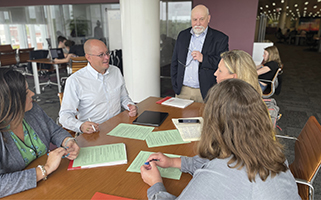Navigating a Pandemic With Moral and Intellectual Leadership
August 01, 2022
Clarity about organizational direction pointed superintendents to their North Star for making difficult decisions amid chaos

Red Steagall is one of America’s great cowboy poets and songwriters. He’s a man who emphasizes the importance of knowing where you’re going and how you plan to get there.
In his song “The Wagon Tongue,” he describes
how late at night on long cattle drives, the cook would point the tongue of the chuck wagon toward the North Star. Tomorrow might be cloudy, the cook would explain. Without landmarks — trees or mountains — on the trail, cowboys easily
could point the herd in the wrong direction. As one chorus rings out:
“’Cause life is like a grassy sea, the trail ain’t always plain
One may lead to pleasure and another lead to pain
But you’ll never lose direction, and you’ll know just where you are
If you’ll always point your wagon tongue toward that old North Star.”
In the pain-filled past two school years that we have all experienced, it is clear, in the face of a terrible pandemic, the best leaders understood their North Star to be commitment to the moral and intellectual foundations of the school district
enterprise.
This overarching lesson affirms what we at the Schlechty Center, which I lead, and we at the National Superintendents Roundtable, where I am executive director, have collectively learned in working with districts and in networking with
leaders across the nation: At its heart, education is a moral enterprise.
The superintendents and boards of education that understand this have a marker pointing them in the right direction, even amid the darkest nights of the soul.
This Content is Exclusive to Members
AASA Member? Login to Access the Full Resource
Not a Member? Join Now | Learn More About Membership
Pillars of the Superintendent as Moral and Intellectual Leader
These pillars, as created by George Thompson, past president of the Schlechty Center, describe the traits and actions of a strong
moral and intellectual leader. They are described frequently as aspirational, but in these past two years of the pandemic, they became real.
A strong moral and intellectual leader:
- Models and develops trust. Gives priority to building personal trust and trust in the organization.
- Clarifies the vision. Consistently and continuously communicates and clarifies a clear and compelling vision of the future.
- Knows what he or she believes. Understands the need to be clear about what he or she believes and understands that shared beliefs are the foundation of the direction of the organization.
- Enhances capacity. Attends to developing the capacity of the organization and the capacity of the people who are part of the organization to support continuous innovation.
- Educates community. Educates the community, especially community leaders, and informs policymakers about the condition of education.
- Thinks and acts strategically. Employs systems thinking to understand how systems are linked to one another and how they interact.
- Personalizes relationships with principals. Develops personal relationships with all principals in the district.
- Unifies central-office staff. Educates central-office staff so they understand and are committed to the direction in which they are being led.
- Shares authority. Shares authority rather than delegates it. Views authority as affective and highly personalized.
- Personalizes his or her relationship with the board. Strives to work as part of a team with the board in order to focus on the needs of children and the future of the community.
More about the pillars of leadership can be found on the Schlechty Center website.
Advertisement
Advertisement
Advertisement
Advertisement


